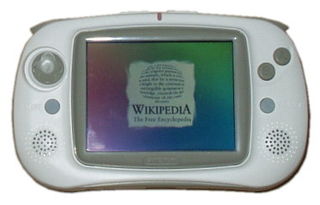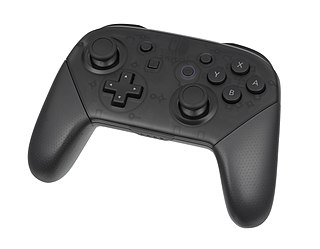
A handheld game console, or simply handheld console, is a small, portable self-contained video game console with a built-in screen, game controls and speakers. Handheld game consoles are smaller than home video game consoles and contain the console, screen, speakers, and controls in one unit, allowing players to carry them and play them at any time or place.

The GP32 is a handheld game console developed by the South Korean company Game Park. It was released on November 23, 2001, in South Korea and distributed in some parts of Europe.

The Visual Memory Unit (VMU), also referred to as the Visual Memory System (VMS) in Japan and Europe, is the primary memory card produced by Sega for the Dreamcast home video game console. The device features a monochrome liquid crystal display (LCD), multiplayer gaming capability, second screen functionality, a real-time clock, file manager, built-in flash memory, and sound capability. Prior to the launch of the Dreamcast, a special Godzilla edition VMU, preloaded with a virtual pet game, was released on July 30, 1998, in Japan.

A gamepad is a type of video game controller held in two hands, where the fingers are used to provide input. They are typically the main input device for video game consoles.

A handheld personal computer (PC), typically built around either a clamshell form factor or a gaming form factor with a gamepad integrated for video games, is a mobile device that is significantly smaller than any standard personal computer (PC), but based on the same principles as PCs. The clamshell form factor is sometimes referred to as a palmtop computer, not to be confused with Palmtop PC which was a name used mainly by Hewlett-Packard.

The V.Smile is a sixth-generation educational home video game console manufactured and released by VTech. The system was first released on August 4, 2004. Its titles are available on ROM cartridges called "Smartridges", a pun on the system's educational nature. Several variants of the V.Smile console are sold, including handheld versions and models with added functionality such as touch tablet integrated controllers or microphones. The V.Motion is a variant that includes motion-sensitive controllers and has titles designed to take advantage of motion-related "active learning".

An ultra-mobile PC, or ultra-mobile personal computer (UMPC), is a miniature version of a pen computer, a class of laptop whose specifications were launched by Microsoft and Intel in Spring 2006. Sony had already made a first attempt in this direction in 2004 with its Vaio U series, which was only sold in Asia. UMPCs are generally smaller than subnotebooks, have a TFT display measuring (diagonally) about 12.7 to 17.8 centimetres, are operated like tablet PCs using a touchscreen or a stylus, and can also have a physical keyboard. There is no clear boundary between subnotebooks and ultra-mobile PCs, but UMPCs commonly have major features not found in the common clamshell laptop design, such as small keys on either side of the screen, or a slide-out keyboard.

Elgato is a brand of consumer technology products. The brand was manufactured and designed by Elgato Systems, founded in 2010 by Markus Fest and was headquartered in Munich, Germany, until 2018 when the brand was sold to Corsair.
EVO Smart Console is a line media PCs and video game consoles marketed in the seventh generation of video game consoles. The system was produced by Envizions, a company based in Anniston, Alabama.

The Game Gadget is an open source gaming handheld that supports music and video playback, open game development, and some e-reader features.

The Neo Geo X (NGX) is a hybrid video game console manufactured by Tommo, licensed by SNK Playmore. Information about the Neo Geo X was first reported in January 2012 and later confirmed in March. It is the first Neo Geo system to be released since the discontinuation of the brand in 2004 and the third Neo Geo handheld console, following the 1999 release of the Neo Geo Pocket Color, which was supported until 2001.

Pocket PC 2000 was the first member of the Windows Mobile family of mobile operating systems that was released on April 19, 2000, and was based on Windows CE 3.0. It is the successor to the operating system aboard Palm-size PCs. Backwards compatibility was retained with such Palm-size PC applications.

GPD Win is a Windows-based palmtop computer equipped with a keyboard and video game controls. It is an x86-based computer that runs Windows 10. It is capable of running any x86 Windows-based application that can run within the confines of the computer's hardware. First announced in October 2015, it was crowdfunded via Indiegogo and two other crowdfunding sites in Japan and China. The GPD Win was released in October 2016.

The Atari VCS is a home video game console produced by Atari, Inc. While its exterior encasing design is intended to pay homage to the Atari 2600, the new Atari VCS plays modern games and streaming entertainment via a Linux-based operating system called AtariOS that will allow users to download and install other compatible games, including those compatible with Windows 10. The system shares a name with Atari, Inc.'s 1977 Video Computer System, usually shortened to VCS, which was renamed to the Atari 2600 in late 1982.

The GPD Win 2 is a Windows-based palmtop computer that is the successor to the GPD Win. It is manufactured by Chinese company GamePad Digital, and crowdfunded just as its predecessor was. Announced in first-quarter 2017, the crowdfunding campaign officially kicked off on January 15, 2018, and quickly surpassed its goal. It was released in May 2018.
The ninth generation of video game consoles began in November 2020 with the releases of Microsoft's Xbox Series X and Series S console family and Sony's PlayStation 5.

The Evercade is a handheld game console developed and manufactured by UK company Blaze Entertainment. It focuses on retrogaming with ROM cartridges that each contain a number of emulated games. Development began in 2018, and the console was released in May 2020, after a few delays. Upon its launch, the console offered 10 game cartridges with a combined total of 122 games.

The GPD Win 3 is a Windows-based handheld computer that is the successor to the GPD Win 2 and GPD Win MAX. It is manufactured by Chinese company Gamepad Digital (GPD), and crowdfunded.
The Ayn Odin is an Android-based handheld video game console created in China by the company Ayn. A retrogaming emulation and mobile gaming console, it is slightly smaller than the Nintendo Switch. It was released in three models of increasing price, the Lite, Base, and Pro. The product of a successful Indiegogo campaign, it was critically praised at the time of release as one of the most powerful handheld consoles for the price, able to reliably play games from the sixth generation of home consoles. A successor, named the Ayn Odin 2 was released in fall 2023.
The Super Pocket is a handheld game console developed by Hyper Mega Tech!, a brand of UK company Blaze Entertainment. In addition to built-in collections of retro video games, the console features a cartridge slot and is compatible with all of Blaze's Evercade cartridges, despite not being branded as an Evercade device. The console was released on 14 November 2023.















